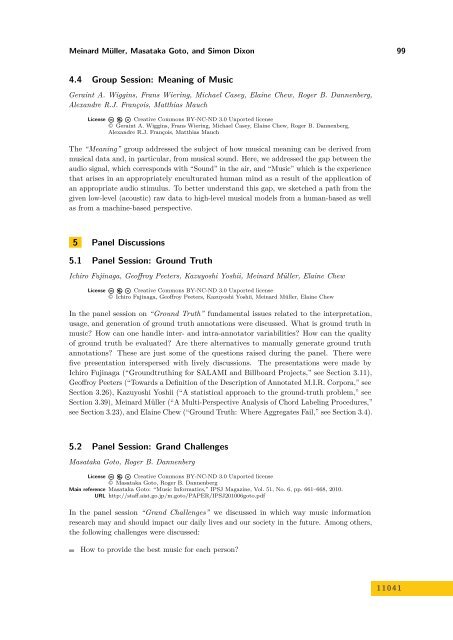Volume 1, Issue 1, January 2011 - DROPS - Schloss Dagstuhl
Volume 1, Issue 1, January 2011 - DROPS - Schloss Dagstuhl
Volume 1, Issue 1, January 2011 - DROPS - Schloss Dagstuhl
You also want an ePaper? Increase the reach of your titles
YUMPU automatically turns print PDFs into web optimized ePapers that Google loves.
Meinard Müller, Masataka Goto, and Simon Dixon 99<br />
4.4 Group Session: Meaning of Music<br />
Geraint A. Wiggins, Frans Wiering, Michael Casey, Elaine Chew, Roger B. Dannenberg,<br />
Alexandre R.J. François, Matthias Mauch<br />
License Creative Commons BY-NC-ND 3.0 Unported license<br />
© Geraint A. Wiggins, Frans Wiering, Michael Casey, Elaine Chew, Roger B. Dannenberg,<br />
Alexandre R.J. François, Matthias Mauch<br />
The “Meaning” group addressed the subject of how musical meaning can be derived from<br />
musical data and, in particular, from musical sound. Here, we addressed the gap between the<br />
audio signal, which corresponds with “Sound” in the air, and “Music” which is the experience<br />
that arises in an appropriately enculturated human mind as a result of the application of<br />
an appropriate audio stimulus. To better understand this gap, we sketched a path from the<br />
given low-level (acoustic) raw data to high-level musical models from a human-based as well<br />
as from a machine-based perspective.<br />
5 Panel Discussions<br />
5.1 Panel Session: Ground Truth<br />
Ichiro Fujinaga, Geoffroy Peeters, Kazuyoshi Yoshii, Meinard Müller, Elaine Chew<br />
License Creative Commons BY-NC-ND 3.0 Unported license<br />
© Ichiro Fujinaga, Geoffroy Peeters, Kazuyoshi Yoshii, Meinard Müller, Elaine Chew<br />
In the panel session on “Ground Truth” fundamental issues related to the interpretation,<br />
usage, and generation of ground truth annotations were discussed. What is ground truth in<br />
music? How can one handle inter- and intra-annotator variabilities? How can the quality<br />
of ground truth be evaluated? Are there alternatives to manually generate ground truth<br />
annotations? These are just some of the questions raised during the panel. There were<br />
five presentation interspersed with lively discussions. The presentations were made by<br />
Ichiro Fujinaga (“Groundtruthing for SALAMI and Billboard Projects,” see Section 3.11),<br />
Geoffroy Peeters (“Towards a Definition of the Description of Annotated M.I.R. Corpora,” see<br />
Section 3.26), Kazuyoshi Yoshii (“A statistical approach to the ground-truth problem,” see<br />
Section 3.39), Meinard Müller (“A Multi-Perspective Analysis of Chord Labeling Procedures,”<br />
see Section 3.23), and Elaine Chew (“Ground Truth: Where Aggregates Fail,” see Section 3.4).<br />
5.2 Panel Session: Grand Challenges<br />
Masataka Goto, Roger B. Dannenberg<br />
License Creative Commons BY-NC-ND 3.0 Unported license<br />
© Masataka Goto, Roger B. Dannenberg<br />
Main reference Masataka Goto: “Music Informatics,” IPSJ Magazine, Vol. 51, No. 6, pp. 661–668, 2010.<br />
URL http://staff.aist.go.jp/m.goto/PAPER/IPSJ201006goto.pdf<br />
In the panel session “Grand Challenges” we discussed in which way music information<br />
research may and should impact our daily lives and our society in the future. Among others,<br />
the following challenges were discussed:<br />
How to provide the best music for each person?<br />
1 1 0 4 1













